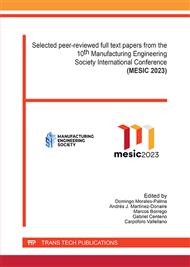[1]
C. K. Chua, C. H. Wong, and W. Y. Yeong, Standards, Quality Control, and Measurement Sciences in 3D Printing and Additive Manufacturing, First ed., Elsevier, 2017.
DOI: 10.1016/b978-0-12-813489-4.00001-5
Google Scholar
[2]
S. Kalpakjian and S.R. Schmid, Manufactura, ingeniería y tecnología, 7a ed. Vol 1 y 2, Pearson Educación, México, 2014.
Google Scholar
[3]
I. Gibson, D. Rosen, and B. Stucker, Additive Manufacturing Technologies. 3D Printing, Rapid Prototyping, and Direct Digital Manufacturing, Second ed., Springer, New York, 2015.
DOI: 10.1007/978-1-4939-2113-3
Google Scholar
[4]
M. Pérez, D. Carou, E. M. Rubio, and R. Teti, Current advances in additive manufacturing, Procedia CIRP. 88 (2020) 439–444.
DOI: 10.1016/j.procir.2020.05.076
Google Scholar
[5]
H. González, Methodology for Hybrid Manufacturing of turbomachinery integral rotary components in thermoresistant superalloys, Department of Mechanical Engineering. Universidad del País Vasco, Bilbao, Doctoral Thesis, 2019.
Google Scholar
[6]
S. Kapil, F. Legesse, R. Kumar, K.P. Karunakaran, Hybrid layered manufacturing of turbine blades, Materials today proceedings. 4(8) (2017) 8837-8847.
DOI: 10.1016/j.matpr.2017.07.234
Google Scholar
[7]
N. Chen, M. Frank, Process planning for hybrid additive and subtractive manufacturing to integrate machining and directed energy deposition, Procedia Manufacturing, 34 (2019) 205-213.
DOI: 10.1016/j.promfg.2019.06.140
Google Scholar
[8]
M. A. Rabalo, E. M. Rubio, Agustina, and A. M. Camacho, Hybrid additive and subtractive manufacturing: evolution of the concept and last trends in research and industry. 16th CIRP Conference on Intelligent Computation in Manufacturing Engineering, July 2022.
Google Scholar
[9]
M. J. Page et al., The PRISMA 2020 statement: An updated guideline for reporting systematic reviews, International Journal of Surgery, 88 (2021) 105906.
Google Scholar
[10]
D. Blanco, E. M. Rubio, M. M. Marin, and B. de Agustina, Propuesta metodológica para revisión sistemática en el ámbito de la ingeniería basada en PRISMA. Congreso Nacional de Ingeniería Mecánica, Jaén, octubre 2021.
DOI: 10.5944/bicim2022.348
Google Scholar
[11]
Information on https://www.afm.es/es/noticias/ibarmia-fabricacion-aditiva-y-mecanizado-multitarea-en-una-misma-maquina-en-emo-milano-hall-5-stand-c10 .
Google Scholar
[12]
M. O. Oyesola, K. Mpofu, N. R. Mathe, and I. A. Daniyan, Hybrid-additive manufacturing cost model: A sustainable through-life engineering support for maintenance repair overhaul in the aerospace, Procedia Manufacturing. 49 (2020) 199–205.
DOI: 10.1016/j.promfg.2020.07.019
Google Scholar
[13]
P. Wüst, A. Edelmann, and R. Hellmann, Areal surface roughness optimization of maraging steel parts produced by hybrid additive manufacturing, Materials. 13(2) (2020) 418-435.
DOI: 10.3390/ma13020418
Google Scholar
[14]
F. Veiga, A. G. del Val, A. Suárez, and U. Alonso, Analysis of the machining process of titanium Ti6Al-4V parts manufactured by wire arc additive manufacturing (WAAM), Materials. 13(3) (2020) 766-781.
DOI: 10.3390/ma13030766
Google Scholar
[15]
T. Ostra, U. Alonso, F. Veiga, M. Ortiz, P. Ramiro, and A. Alberdi, Analysis of the machining process of inconel 718 parts manufactured by laser metal deposition, Materials. 12(13) (2019) 2159-2173.
DOI: 10.3390/ma12132159
Google Scholar
[16]
F. Meiners, J. Ihne, P. Jürgens, S. Hemes, M. Mathes, I. Sizova, M. Bambach, R. Hama-Saleh, A. Weisheit, New hybrid manufacturing routes combining forging and additive manufacturing to efficiently produce high performance components from Ti-6Al-4V, Procedia Manufacturing. 47 (2020) 261–267.
DOI: 10.1016/j.promfg.2020.04.215
Google Scholar
[17]
F. Careri, D. Umbrello, K. Essa, M. M. Attallah, and S. Imbrogno, The effect of the heat treatments on the tool wear of hybrid Additive Manufacturing of IN718, Wear. 470-471 (2021) 203617.
DOI: 10.1016/j.wear.2021.203617
Google Scholar
[18]
R. Bejjani, E. Bamford, S. Cedergren, A. Archenti, and A. Rashid, Variations in the surface integrity of Ti-6Al-4V by combinations of additive and subtractive manufacturing processes, Materials. 13(8) (2020) 1825.
DOI: 10.3390/ma13081825
Google Scholar
[19]
D. Strong, M. Kay, B. Conner, T. Wakefield, and G. Manogharan, Hybrid manufacturing – integrating traditional manufacturers with additive manufacturing (AM) supply chain, Additive Manufacturing. 21 (2018) 159–173.
DOI: 10.1016/j.addma.2018.03.010
Google Scholar
[20]
L. Li, A. Haghighi, and Y. Yang, A novel 6-axis hybrid additive-subtractive manufacturing process: Design and case studies, Journal of Manufacturing Processes. 33 (2018) 150–160.
DOI: 10.1016/j.jmapro.2018.05.008
Google Scholar
[21]
M. Behandish, S. Nelaturi, and J. de Kleer, Automated process planning for hybrid manufacturing, CAD Computer Aided Design. 102 (2018) 115–127.
DOI: 10.1016/j.cad.2018.04.022
Google Scholar
[22]
Y. Li, Q. Han, I. Horváth, and G. Zhang, Repairing surface defects of metal parts by groove machining and wire + arc based filling, Journal of Materials Processing Technology. 274 (2019) 116268.
DOI: 10.1016/j.jmatprotec.2019.116268
Google Scholar
[23]
C. Guo, X. Liu, and G. Liu, Surface finishing of fdm-fabricated amorphous polyetheretherketone and its carbon-fiber-reinforced composite by dry milling, Polymers. 13(13) (2021) 2175.
DOI: 10.3390/polym13132175
Google Scholar
[24]
J. D. Pérez-Ruiz, L. N. L. de Lacalle, G. Urbikain, O. Pereira, S. Martínez, and J. Bris, On the relationship between cutting forces and anisotropy features in the milling of LPBF Inconel 718 for near net shape parts, International Journal of Machine Tools Manufacture. 170 (2021) 103801.
DOI: 10.1016/j.ijmachtools.2021.103801
Google Scholar
[25]
D. Strong, I. Sirichakwal, G. P. Manogharan, and T. Wakefield, Current state and potential of additive - Hybrid manufacturing for metal parts, Rapid Prototyping Journal. 23(3) (2017) 577–588.
DOI: 10.1108/rpj-04-2016-0065
Google Scholar



